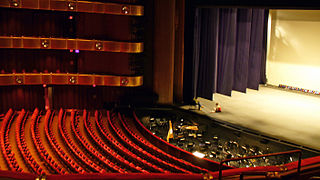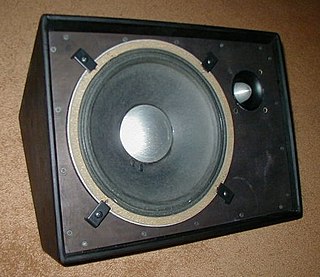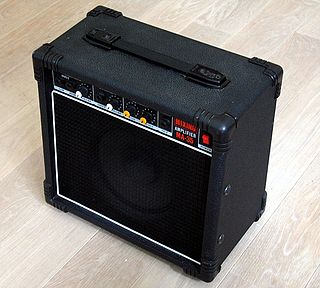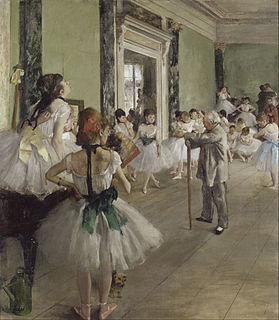
An electric guitar is a guitar that uses one or more pickups to convert the vibration of its strings into electrical signals. The vibration occurs when a guitar player strums, plucks, fingerpicks, slaps or taps the strings. The pickup generally uses electromagnetic induction to create this signal, which being relatively weak is fed into a guitar amplifier before being sent to the speaker(s), which converts it into audible sound.

An orchestra is a large instrumental ensemble typical of classical music, which combines instruments from different families, including bowed string instruments such as the violin, viola, cello, and double bass, brass instruments such as the horn, trumpet, trombone and tuba, woodwinds such as the flute, oboe, clarinet and bassoon, and percussion instruments such as the timpani, bass drum, triangle, snare drum and cymbals, each grouped in sections. Other instruments such as the piano and celesta may sometimes appear in a fifth keyboard section or may stand alone, as may the concert harp and, for performances of some modern compositions, electronic instruments.

String instruments, stringed instruments, or chordophones are musical instruments that produce sound from vibrating strings when the performer plays or sounds the strings in some manner.

In music, timbre is the perceived sound quality of a musical note, sound or tone. Timbre distinguishes different types of sound production, such as choir voices and musical instruments, such as string instruments, wind instruments, and percussion instruments. It also enables listeners to distinguish different instruments in the same category.

A recording studio is a specialized facility for sound recording, mixing, and audio production of instrumental or vocal musical performances, spoken words, and other sounds. They range in size from a small in-home project studio large enough to record a single singer-guitarist, to a large building with space for a full orchestra of 100 or more musicians. Ideally both the recording and monitoring spaces are specially designed by an acoustician or audio engineer to achieve optimum acoustic properties.

An electric piano is an electric musical instrument which produces sounds when a performer presses the keys of the piano-style musical keyboard. Pressing keys causes mechanical hammers to strike metal strings, metal reeds or wire tines, leading to vibrations which are converted into electrical signals by magnetic pickups, which are then connected to an instrument amplifier and loudspeaker to make a sound loud enough for the performer and audience to hear. Unlike a synthesizer, the electric piano is not an electronic instrument. Instead, it is an electro-mechanical instrument. Some early electric pianos used lengths of wire to produce the tone, like a traditional piano. Smaller electric pianos used short slivers of steel to produce the tone. The earliest electric pianos were invented in the late 1920s; the 1929 Neo-Bechstein electric grand piano was among the first. Probably the earliest stringless model was Lloyd Loar's Vivi-Tone Clavier. A few other noteworthy producers of electric pianos include Baldwin Piano and Organ Company and the Wurlitzer Company.

An instrument amplifier is an electronic device that converts the often barely audible or purely electronic signal of a musical instrument into a larger electronic signal to feed to a loudspeaker. An instrument amplifier is used with musical instruments such as an electric guitar, an electric bass, electric organ, synthesizers and drum machine to convert the signal from the pickup or other sound source into an electronic signal that has enough power, due to being routed through a power amplifier, capable of driving one or more loudspeaker that can be heard by the performers and audience.

An electronic keyboard or digital keyboard is an electronic musical instrument, an electronic or digital derivative of keyboard instruments. Broadly speaking, the term electronic keyboard or just a keyboard can refer to any type of digital or electronic keyboard instrument. These include synthesizers, digital pianos, stage pianos, electronic organs and digital audio workstations. However, an electronic keyboard is more specifically a synthesizer with a built-in low-wattage power amplifier and small loudspeakers.

A pit orchestra is a type of orchestra that accompanies performers in musicals, operas, ballets, and other shows involving music. The terms was also used for orchestras accompanying silent movies when more than a piano was used. In performances of operas and ballets, the pit orchestra is typically similar in size to a symphony orchestra, though it may contain smaller string and brass sections, depending upon the piece. Such orchestras may vary in size from approximately 30 musicians to as many as 90–100 musicians. However, because of financial, space, and volume concerns, the musical theatre pit orchestra in the 2000s is considerably smaller.

An orchestra pit is the area in a theater in which musicians perform. Orchestral pits are utilized in forms of theatre that require music or in cases when incidental music is required. The conductor is typically positioned at the front of the orchestral pit facing the stage.

A rehearsal is an activity in the performing arts that occurs as preparation for a performance in music, theatre, dance and related arts, such as opera, musical theatre and film production. It is undertaken as a form of practising, to ensure that all details of the subsequent performance are adequately prepared and coordinated. The term "rehearsal" typically refers to ensemble activities undertaken by a group of people. For example, when a musician is preparing a piano concerto in their music studio, this is called "practicing", but when they practice the concerto with an orchestra, this is called a "rehearsal". The music rehearsal takes place in a music rehearsal space.

Live sound mixing is the blending of multiple sound sources by an audio engineer using a mixing console or software. Sounds that are mixed include those from instruments and voices which are picked up by microphones and pre-recorded material, such as songs on CD or a digital audio player. Individual sources are typically equalised to adjust the bass and treble response and routed to effect processors to ultimately be amplified and reproduced via a loudspeaker system. The live sound engineer listens and balances the various audio sources in a way that best suits the needs of the event.
Acoustic enhancement is a subtle type of sound reinforcement system used to augment direct, reflected, or reverberant sound. While sound reinforcement systems are usually used to increase the sound level of the sound source, acoustic enhancement systems are typically used to increase the acoustic energy in the venue in a manner that is not noticed by the audience. The correctly installed systems replicate the desired acoustics of early reflections and reverberation from a room that is properly designed for Acoustic Music. An additional benefit of these systems is that the room acoustics can be changed or adjusted to be matched to the type of performance. The use of Acoustic Enhancement as Electronic Architecture offers a good solution for multi-use performance halls that need to be "dead" for amplified music, and are used occasionally for acoustic performances. These systems are often associated with acoustic sound sources like a chamber orchestra, symphony orchestra, or opera, but have also found acceptance in a variety of applications and venues that include rehearsal rooms, recording facilities conference rooms, sound stages, sports arenas, and outdoor venues.

A stage monitor system is performer-facing loudspeakers known as monitor speakers or stage monitors on stage during live music performances in which a PA system or sound reinforcement system is used to amplify the performers' singing, music, speech and other sounds for the audience. In Britain the term foldback is often used to describe the system. Monitor speakers are useful when amplified instruments are used with acoustic instruments and voice. Monitor speakers often include a single full-range loudspeaker and a horn in a cabinet. Monitor speakers have numerous features which facilitate their transportation and protection, including handles, metal corner protectors, sturdy felt covering or paint and a metal grille to protect the speaker. There are two types of monitors: passive monitors consist of a loudspeaker and horn in a cabinet ; active monitors have a loudspeaker, horn and a power amplifier in a single cabinet, which means the signal from the mixing board can be plugged straight into the monitor speaker.

An audition is a sample performance by an actor, singer, musician, dancer or other performer. It typically involves the performer displaying their talent through a previously memorized and rehearsed solo piece or by performing a work or piece given to the performer at the audition or shortly before. In some cases, such as with a model or acrobat, the individual may be asked to demonstrate a range of professional skills. Actors may be asked to present a monologue. Singers will perform a song in a popular music context or an aria in a Classical context. A dancer will present a routine in a specific style, such as ballet, tap dance or hip-hop, or show his or her ability to quickly learn a choreographed dance piece.
This is a list of jazz and popular music terms that are likely to be encountered in printed popular music songbooks, fake books and vocal scores, big band scores, jazz, and rock concert reviews, and album liner notes. This glossary includes terms for musical instruments, playing or singing techniques, amplifiers, effects units, sound reinforcement equipment, and recording gear and techniques which are widely used in jazz and popular music. Most of the terms are in English, but in some cases, terms from other languages are encountered.

A keyboard amplifier is a powered electronic amplifier and loudspeaker in a wooden speaker cabinet used for amplification of electronic keyboard instruments. Keyboard amplifiers are distinct from other types of amplification systems such as guitar amplifiers due to the particular challenges associated with making keyboards sound louder on stage; namely, to provide solid low-frequency sound reproduction for the deep basslines which keyboards can play and crisp high-frequency sound for the high-register notes. Another difference between keyboard amplifiers and guitar/bass amplifiers is that keyboard amps are usually designed with a relatively flat frequency response and low distortion. In contrast, many guitar and bass amp designers purposely make their amplifiers modify the frequency response, typically to "roll off" very high frequencies, and most rock and blues guitar amps, and since the 1980s and 1990s, even many bass amps are designed to add distortion or overdrive to the instrument tone.

Offstage musicians and singers are performers who play instruments and/or sing backstage, out of sight of the audience, during a live popular music concert at which the main band is visible playing and singing onstage. The sound from the offstage musicians or singers is captured by a microphone or from the output of their instrument, and this signal is mixed in with the singing and playing of the onstage performers using an audio console and a sound reinforcement system. Offstage backup singers are also used in some Broadway musicals, as have offstage instrumentalists, in cases where an onstage actor needs to appear to play an instrument.




















